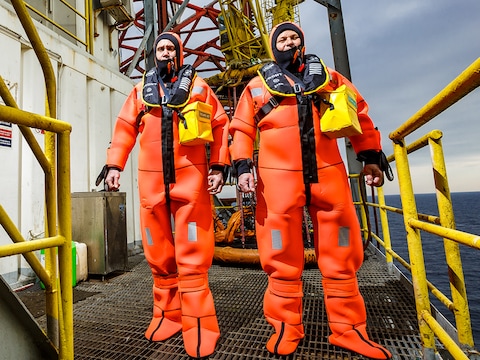Often just referred to as survival suits, immersion survival suits are vital safety gear meant to protect anyone caught in cold water situations. Designed especially to avoid hypothermia and guarantee buoyancy, these suits are vital for marine safety. This is a thorough analysis of the goals and advantages of an immersion survival suit, including with its function alongside other essential safety tools like a self-contained breathing system.
Protection Against Hypothermia
How Immersion Survival Suits Combat Cold Water Risks?
An immersion survival suit’s main use is to shield people from hypothermia. A person falling into cold water quickly loses heat, which may cause hypothermia in minutes. Designed to be thermal insulators, immersion survival suits serve to retain body heat and keep the user comfortable. Designed from materials with great insulating qualities, these suits provide a vital line of protection against the extreme cold of open seas, therefore assuring that people could live until rescue.
Buoyancy and Floating Assistance
Ensuring Survival in Emergencies
Apart from thermal protection, immersion survival suits provide buoyancy, which enables people to float in the water. Crucially in avoiding drowning is keeping the wearer’s head and body above the waterline, which the suit is designed to do. Particularly in stormy waves, this buoyant characteristic is very important during marine emergencies when conventional life jackets could not provide enough support. These suits increase the possibilities of a successful rescue effort by making sure people stay visible and floating.
Complementing Safety Equipment
The Role of Immersion Suits with Breathing Apparatus
Immersion survival suits complement other safety gear such the self contained breathing apparatus (SCBA). While immersion suits provide thermal protection and buoyancy, SCBAs guarantee a supply of breathing air in case of an emergency when the air quality may be compromised, say during a fire or chemical leak. These devices used together provide a complete safety system that meets criteria for human safety as well as environmental risks. The cooperation among these tools improves general survival possibilities in an emergency.
Compliance with Safety Standards
Meeting International Maritime Regulations
The International Maritime Organization’s (IMO) safety regulations, for example, are followed in the construction of immersion survival suits. These criteria guarantee that the suits effectively provide the required buoyancy and protection. Following these rules ensures that the suits have been evaluated for dependability and quality, thereby offering piece of mind that they will operate as intended during an emergency.
Regular Testing and Maintenance
Ensuring Suit Integrity and Functionality
Regular testing and inspection help immersion survival suits remain functional. Companies like as Dipti Fire Services provide thorough testing services to guarantee that every fit stays in best shape. Frequent maintenance inspections guarantee that the suits will operate as expected when required by helping to spot and fix any problems before they become problematic. Maintaining high safety standards and guaranteeing that all safety equipment is ready for use depend on this proactive attitude to testing and service.
Conclusion
Essential for marine safety, immersion survival suits provide buoyancy in cold water crises and guard against hypothermia. To provide a complete safety solution, they cooperate with additional safety equipment like self-contained breathing apparatus. Following international safety standards and undergoing frequent testing and maintenance guarantees that these suits will provide consistent protection when most needed. Maintaining life at sea and becoming ready for any possible crisis depend on investing in premium immersion survival suits.
